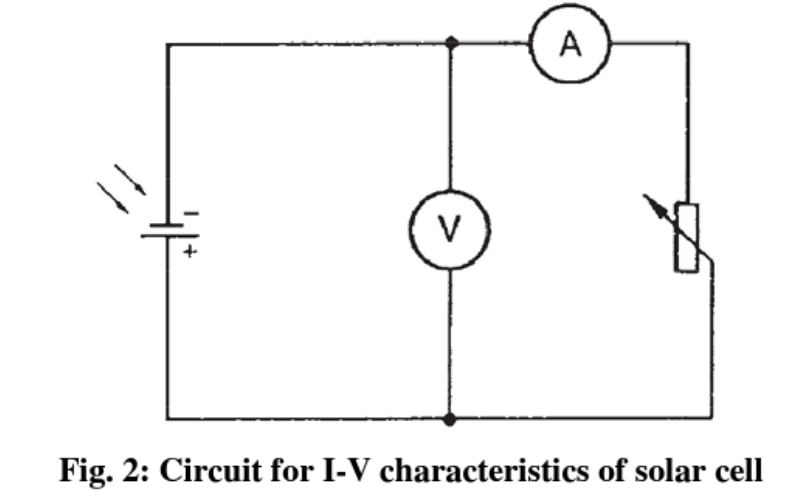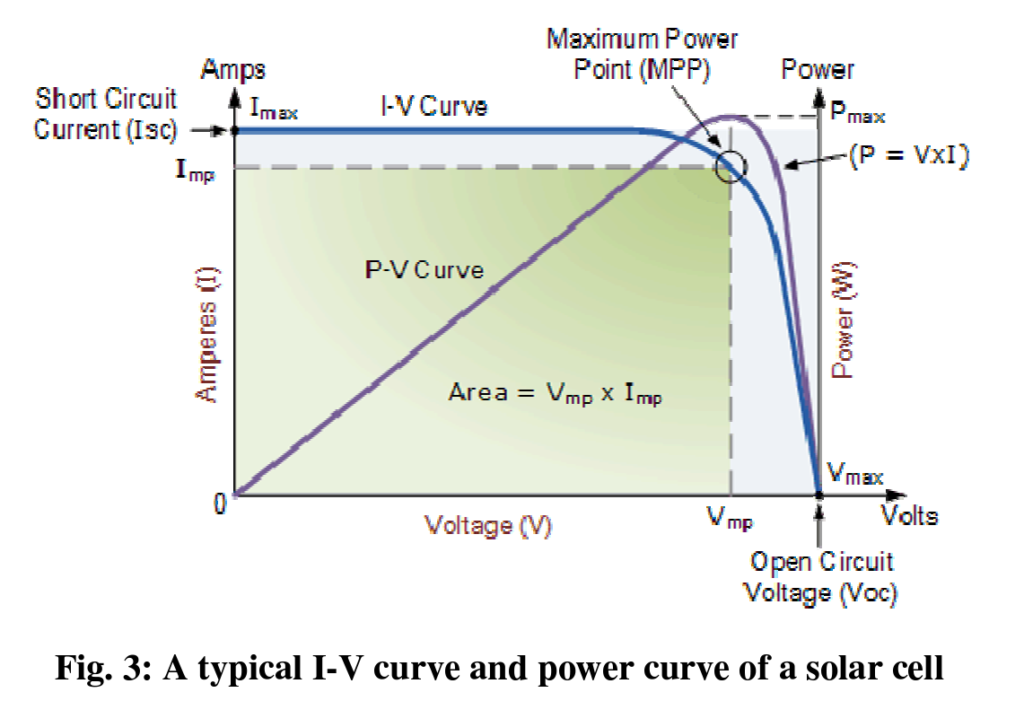Experiment No.: 1
Experimemt Name :
Plot I-V Characteristics of Photovoltaic Cell Module and Find Out the Solar Cell Parameters i.e. Open Circuit Voltage, Short Circuit Current, Voltage-current-power at Maximum Power Point, Fill factor and Efficiency.
Objective:
- To plot I-V characteristics curve of pv cell module
- To find out open circuit voltage, short circuit current
- To find out voltage-current-power at maximum power point
- To find out fill factor & efficiency
Theory:
Solar cell is the basic unit of solar energy generation system where electrical energy is extracted directly from light energy without any intermediate process. The working of a solar cell solely depends upon its photovoltaic effect, hence a solar cell also known as photovoltaic cell. A solar cell is basically a semiconductor p-n junction device. It is formed by joining ptype (high concentration of hole or deficiency of electron) and n-type (high concentration of electron) semiconductor material. at the junction excess electrons from n-type try to diffuse to p-side and vice-versa. Movement of electrons to the p-side exposes positive ion cores in n-side, while movement of holes to the n-side exposes negative ion cores in the p-side. This results in an electric field at the junction and forming the depletion region. When sunlight falls on the solar cell, photons with energy greater than band gap of the semiconductor are absorbed by the cell and generate electron-hole (e-h) pair. These e-h pairs migrate respectively to n- and p- side of the pn junction due to electrostatic force of the field across the junction. In this way a potential difference is established between two sides of the cell. Typically a solar or photovoltaic cell has negative front contact and positive back contact. A semiconductor p-n junction is in the middle of these two contacts like a battery. If these two sides are connected by an external circuit, current will start flowing from positive to negative terminal of the solar cell. This is basic working principle of a solar cell. For silicon, the band gap at room temperature is Eg = 1.1 eV and the diffusion potential is UD = 0.5 to 0.7 V. Construction of a Si solar cell is depicted in figure-1.

A typical circuit for measuring I-V characteristics is shown in Figure-2. From this characteristics various parameters of the solar cell can be determined, such as: short-circuit current (ISC), the open-circuit voltage (VOC), the fill factor (FF) and the efficiency. The rating of a solar panel depends on these parameters.
The short-circuit current is the current through the solar cell when the voltage across the solar cell is zero (i.e., when the solar cell is short circuited). is due to the generation and collection of light-generated carriers. For an ideal solar cell at most moderate resistive loss mechanisms, the short-circuit current and the light-generated current are identical. Therefore, the short-circuit current is the largest c rrent which may be drawn from the solar cell.
The open-circuit voltage, VOC, is the maximum voltage available from a solar cell, and this occurs at zero current. The open-circuit voltage corresponds to the amount of forward bias on the solar cell due to the bias of the solar cell junction with the light-generated current.
The “fill factor“, more commonly known by its abbreviation “FF”, is a parameter which, in conjunction with Voc and Isc, determines the maximum power from a solar cell. The FF is defined as the ratio of the maximum power from the solar cell to the product of Voc and Isc. Graphically, the FF is a measure of the “squareness” of the solar cell an the largest rectangle which will fit in the IV curve as shown in Figure-3.
The efficiency is the most commonly used parameter to compare the performance of one solar cell to another. Efficiency is defined as the ratio of energy output from the solar cell to input energy from the sun. In addition to reflecting the performance of the solar cell itself, the efficiency depends on the spectrum and intensity of the incident sunlight and the temperature of the solar cell.
Circuit Diagram:

I-V Characteristics Curve of Solar Cell :

Procedure:
- Connect the solar cell to the potentiometer and multimeters as shown in Fig.2. Set the potentiometer at the minimum.
- Vary the potentiometer and record the values of current and voltage across the solar cell.
- Plot I-V curve and estimate short circuit current, no load voltage. Determine the maximum power output at the turning points on the curves (marked by a circle in Fig. 3).
Observation Table: Solar PV Panel under Sunlight
| Sl. No. | Voltage (V) | Current (A) |
| 1. | 0.38 | 1.5 |
| 2. | 6.83 | 1.0 |
| 3. | 18.66 | 0.8 |
| 4. | 19.39 | 0.6 |
| 5. | 20.09 | 0.45 |
| 6. | 21.01 | 0.35 |
| 7. | 21.08 | 0.25 |
| 8. | 22.0 | 0.20 |
| 9. | 22.5 | 0.20 |
Graph:
Plot I-V characteristics for each filter. Determine the no-load voltage and short circuit current. Estimate the maximum power output in each case.

Calculation:
From the graph, we can easily find out the Fill Factor,
Fill factor = (19.38/33.75) = 57.42 %
Apparatus Used:
| Sl. No. | Name of the Apparatus | Specification | Quantity | Maker’s Name |
| 1. | Solar PV Panel | 12V, 50W, Mono PERC Solar Panel Max. Power (Pmax) : 50Wp Max. Power Voltage (Vmp) : 20.00 V Max. Power Current (Imp) : 2.51 A Open Circuit Voltage (Voc) : 22.5 V Short Circuit Current (Isc) : 2.65 A Max. System Voltage : 600 V | 1 | Loom Solar |
| 2. | Rheostat | 500W, 0-100Ω, 5A, Wire Wound | 1 | |
| 3. | Digital Multimeter as Voltmeter | 0-1000 V DC, 750V AC, 0-10 A | 1 | Akademika |
| 4. | Ammeter | PMMC type, 0-5 A DC | 1 | K.E.W |
Remarks:
Due to partial cloudy partial sunny weather, the output of the solar panel was varing continuously. As a result we felt a problem regarding the ammeter and voltmeter readings. Ignoring the weather issue, the experiment was performed successfully.
